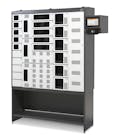Analysts Discuss Hype Surrounding RFID During Gartner Symposium
Radio frequency identification (RFID) has climbed from relative obscurity to become one of today's most discussed retail technologies, spurred by industry speculation that a 5-cent RFID tag will be available in the near future, according to Gartner, Inc.
"RFID technology holds exciting opportunities for almost every business," said Stephen Smith, research vice president at Gartner. "But rather than ask at what price does RFID become effective, retailers should identify if a specific business case exists for the technology in their business based on today's price."
Future trends for RFID in retailing were presented here during the Gartner Symposium/ITxpo 2004. The six-day conference runs through October 22.
"The use of RFID to capitalize on data flow in global supply chains could be one of the most significant developments in business strategy since companies first recognized the importance of information flow," said Smith. "This means we can expect tremendous change ahead for product-centric organizations."
Companies will go through a two-phase adoption of RFID. First will be the creation of RFID-enabled business processes, using RFID within the context of existing business processes and thereby achieving marginal benefits from it. The second phase will be when companies adopt RFID-centric business processes, involving a radical re-engineering of business processes.
"RFID technology and the business benefits it promises will not arrive with a big bang," said Smith. "High capital costs, imperfect read-rates, unproven systems and uncertainty around standards will all need to be addressed before retailers can adopt and benefit from the technology. This means that over the next 10 years, retailers will continue to use barcodes and gradually introduce RFID tagging, creating an environment of co-existence."
As for the 5-cent RFID tag myth, Smith said, "There are conflicting problems with assembling low-cost tags. One of the primary things vendors must do to reduce tag cost is reduce the size of the chip. However, reductions in the size of the chip make assembly more expensive. Currently, no vendor has been able to get out of this paradox."
Passive tags today cost from 40 cents to $10. Active tags usually start at $4 to $5, increasing to hundreds of dollars. By 2009, the most competitive RFID tags will cost 20 cents.

